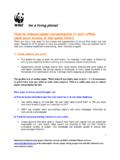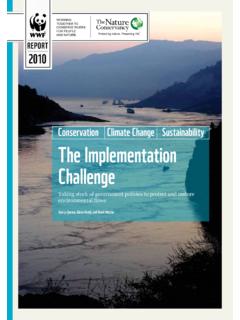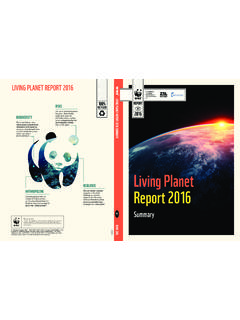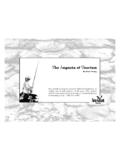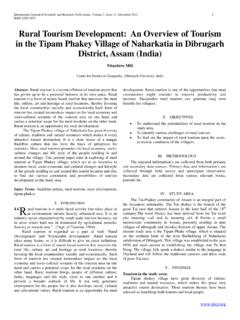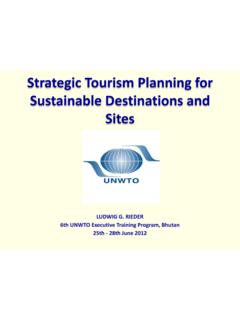Transcription of Detailed Project Proposal on Development of Tourism in …
1 Detailed Project Proposal on Development of Tourism in the Javakheti National Park Support Zone 2012 - 2013. Content: 1. Project Primary Information and Situational Analysis 2. Description of the Problem and Project Objectives Subsequent from the Problems 3. Project Objectives and Feasible Outcomes 4. Link between Planned Components and the Establishment of the Javakheti National Park in Georgia Project 5. Criteria and Methods for Selection of Beneficiaries 6. Number of Beneficiaries and its Substantiation in accordance with Poverty, Gender Balance and Other Factors 7. Project Implementation Stages and Activities 8. Project Implementation Detailed Schedule (Chart for Summarising Distribution of Activities in Timeline).
2 9. Detailed Budget of the Project 10. Economic Indicators and Calculation 11. Risks and Assumptions that May Impact on Achieving Goals and Mitigation Strategies 12. Project Implementation Methodology Responsibilities of Implementing Parties 13. Substantiation of Project Sustainability 14. Efficiency Indicators of Project Implementation 15. Project Implementation Monitoring Chart and Methods 16. Additional Information 17. Appendices: Appendix 1 Study Programmes in Accordance with Training Courses Appendix 2 Chart for Summarising Distribution of Activities in Timeline Appendix 3 - Questionnaire on Public Perception and Monitoring and Evaluation of Social Impact Appendix 4 - List of Potential Guides Appendix 5 Business Plans Appendix 6 Project Budget 2.
3 1. Project Primary Information and Situational Analysis Javakheti is located in the southern part of Georgia. Geographically, it is located in the extreme northern part of the country's Middle East Highland. The north of Javakheti is bordered by the Trialeti Ridge Slopes while the eastern and southern parts are surrounded by the Abul-Samsar and Javakheti Ranges which gradually transform into Turkey's north-eastern plateau (the Childir ildir . Lake area). In the west, the Javakheti Range is surrounded by the deep valley of the River Kura. The total area of the Range is approximately 700 km2 and its absolute height varies from 1,500 to 3,300 metres.
4 Javakheti is the part of historical Meskheti (Samtskhe-Javakheti). It consists of two administrative territorial entities; namely, the municipalities of Ninotsminda and Akhalkalaki. These municipalities are comprised of 98 settlements including 96 villages and two towns. The biggest town, located in the Javakheti Range, is Akhalkalaki with a population of 12,000-15,000; Ninotsminda's population is 6,900. In the region, 80% of the population lives in rural areas. The total number of population in these two municipalities is 102,400 (67,300 in Akhalkalaki and 35,100 in Ninotsminda). Population density may vary in accordance with vertical zonality. Density varies from 50 to 100.
5 Persons per 1 km2 at an altitude of 1,700-2,000 metres. Population density slightly exceeds 15. people per 1 km2 at an altitude higher than 2,000 metres. In summer, the number of population of the Javakheti Highland increases since people from other regions come here to use the Javakheti Mountains as summer pastures. Javakheti Protected Areas, which was legally established in 2011, is part of the system of Protected Areas in Georgia. It was established under the Georgian Law On the Establishment of Javakheti Protected Areas and Management and includes the following categories of Protected Areas: a. Javakheti National Park b. Kartsakhi Wetland Sanctuary c.
6 Sulda Wetland Sanctuary d. Kartsakhi Lake Sanctuary e. Bughdasheni Lake Sanctuary f. Madatapa Lake Sanctuary The establishment of Javakheti National Park was funded by KFW (Kreditanstalt f r Wiederaufbau). and is implemented by WWF Germany and the WWF Caucasus Programme Office of Consortium in co-operation with the Agency of Protected Areas under the Ministry of Environment of Georgia. The main purpose of the establishment of the Javakheti Protected Areas is to protect the representative sections of the Javakheti Mountain ecosystems and wetlands. Reserves are created to protect the lakes and marshes which are separated from the Park. The Park and the Reserves include important habitats of flora and fauna and are eco-regionally and internationally important resting places for migratory birds.
7 The third most important route of migratory birds in the Caucasus passes through this area (other routes are the Caspian Sea and the Black Sea). The establishment of Protected Areas echoes the requirements of the Convention on Biological Diversity (CBD), which 3. Georgia joined in 1994, and the obligations under the Convention on Wetlands of International Importance, Especially Territories Suitable for Water Birds (the Ramsar Convention; Georgia joined in 1997). The Javakheti Protected Areas Supporting Zone has ten villages: six are located in the Municipality of Akhalkalaki and four are located in the Municipality of Ninotsminda (see Table 1). The number of population of these ten settlements is 4,750, which includes 1,732 households.
8 The largest village is Sulda, followed in size by Kartsakhi and Dadeshi, all of which are located in the Municipality of Akhalkalaki. Table 1. Number of Population in Javakheti Protected Areas Support Zone Number of Registered Name registered population households Akhalkalaki Municipality (villages from Javakheti Protected Area Supporting Zone only). Sulda 1,100 505. Miasnikiani 140 42. Bozali 206 75. Dadeshi 885 386. Kartsakhi 987 300. Filipovka 73 25. Ninotsminda Municipality (villages from Javakheti Protected Area Supporting Zone only). Patara Khanchali 683 263. Epremovka 150 380. Zhdanovo 446 80. Sameba 80 18. Total 4,750 1,732. The population of target villages amounts to some 1,700 households, which is around 4,700.
9 Persons of whom 859 are pensioners and about 1,040 are children. 4. Distribution of Population by Age Groups Pensioners, 18%. Able-bodied population, Under 18 years 60% of age, 22%. Only a very small percentage of the population capable for work is officially employed with the majority of them in positions of teachers and representatives of territorial bodies. A small part of the population has small businesses such as grocery shops and milk production businesses, amongst others. The remaining part of the population, not considering those who have left their places of residence for temporary employment elsewhere, are considered as self-employed. Employment Temporary employment, 1% Employed, 9%.
10 Private business, 1%. Self-employed, 89%. Of those identified as self-employed, these members of the population are working in the agricultural sector which is the leading sector of the region. Farming largely depends upon the location of the village above sea-level. Cattle-breeding, cultivation of potatoes and grain crops and honey production are the most typical economic activities of the local people. Table 2. Data on Gender, Age and Educational Level of the Population Number of Persons 4,750. Men 2,288. Women 2,462. 5. Retired of both sexes 846. Aged 0-16 years 1,038. Aged 18-59 years 2,869. Employed 201. Self-employed 2,641. Outside workers 20.

